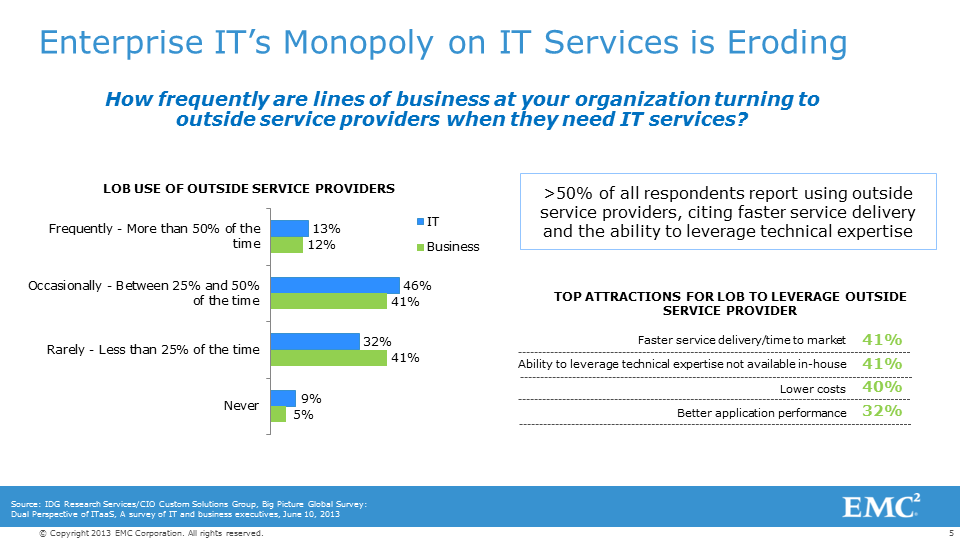I was pleasantly surprised to see that my IT as a Service Broker discussion at the recent 2014 MIT Sloan CIO Symposium drew a standing room only crowd.
The Symposium brings together MIT thought leadership with the real world experience of CIOs across a host of industries ranging from retail and healthcare to public sector, telecommunications, and financial services—the kind of senior IT managers I meet and talk with every day. Their interest in the services broker topic reflects a growing sense among those on the front lines that IT is at a watershed moment.
As every company, in every industry, becomes more IT centric, now is the time for IT to increase its connection to the business — or risk losing that connection completely.
Raising the Services Bar
It may seem counter-intuitive—with the ever wider choice of pay-per-use public cloud services and consumer devices available to business users—to say that CIOs are in a stronger position than ever before to redefine and augment the relationship between business and IT.
But it’s true for CIOs who see external service providers as more than a threat. They are also a resource—and an opportunity to lift the covers on rogue activities.
After all, it’s not just IT that loses control when internal users purchase cloud services on their company credit cards. Enterprises are increasingly aware that this unmanaged “shadow IT” paradigm exposes their business to potentially harmful security threats, data loss, regulatory non-compliance, legal infractions, and added expense.
Companies are coming to realize that achieving success requires more than better, faster, cost-efficient IT. Rather, it requires more strategic and intelligent business use of IT.

Consultative IT Service Broker
More than ever before, internal IT organizations are uniquely positioned to embody a trusted expert and consultative role. They can help businesses identify and “right-source” the technology enabled business services needed to achieve strategic objectives, while making the best possible use of internal and external resources.
Technically, IT services brokering is practical, using proven technologies available today. New virtualization and cloud management technologies, for example, can automate the dynamic movement of workloads to the ‘best’ infrastructure and middleware environment—internal or external—seamlessly and securely.
What’s pacing the transition of most IT organizations to service brokering models is no longer the availability of suitable technology – it’s the people and process side of this change. To succeed as an enterprise services broker, IT must become:
-
- Market-driven – meaning responsible to its business unit’s services needs rather than designing services backwards from those needs
-
- “P&L focused” – meaning IT appreciates that its business users DO have a choice about where they source IT today, and if internal IT is not providing a cost effective solution, P&L driven business units may find other sources of IT supply
-
- Front-office rather than back-office oriented – meaning IT must learn to market its capabilities and not wait (as monopolies might) for orders to come in the door
IT must become a professional services organization delivering a superior ‘customer’ experience while also retaining elasticity to help manage cost requirements (what do I need to buy; what am I currently using; will I be able to scale) for their growth trajectory.
Start with the User Experience
This shift from a technology to a service-oriented outlook begins by looking at the needs of business users. These users seek agility, speed, and time to market for their new ideas. It is the historical lack of such attributes that has business users looking to alternate sources of IT like public cloud.
Leading edge IT organizations – embracing the tenants of IT services broker models – are matching or exceeding the agility, security, and cost point of public cloud alternatives. IT organizations can begin by offering basic IT as a service platform provisioning through a self-service portal (see image right) that “consumerizes” and simplifies access to services.
In addition to providing compelling and unified point of access for business users, the portal and underlying service catalog becomes a powerful point of control for IT.
It’s how IT establishes and enforces enterprise standards, keeps internal what needs to be internal, aligns investments with emerging business needs, technologies, and industry standards, and leverages what third parties do best.
How to broker external and internal IT services for business advantage and reinvent the relationship between business and IT will vary from enterprise to enterprise.
What’s clear is that it’s a conversation that needs to begin now.
The MIT Sloan CIO Symposium posted video of my presentation to YouTube: